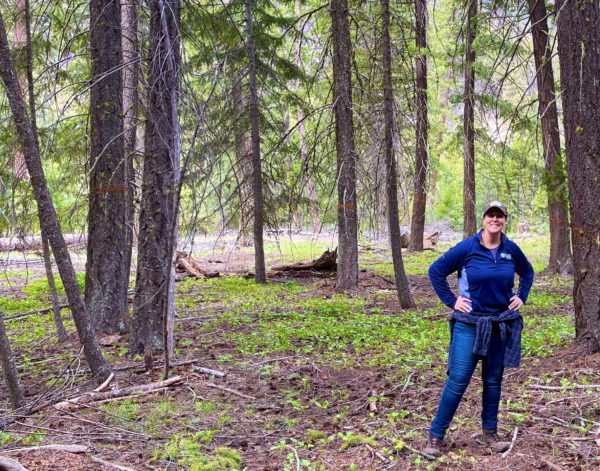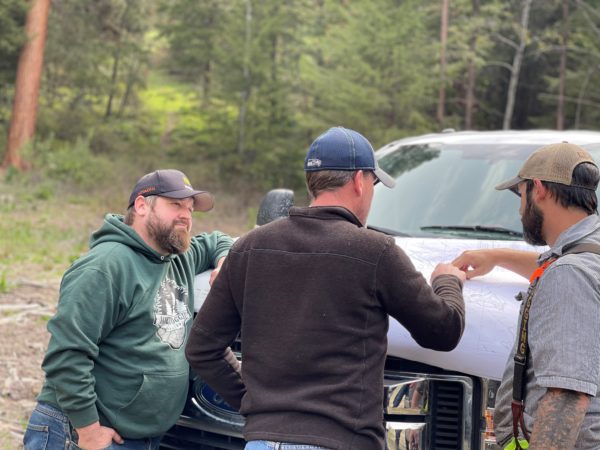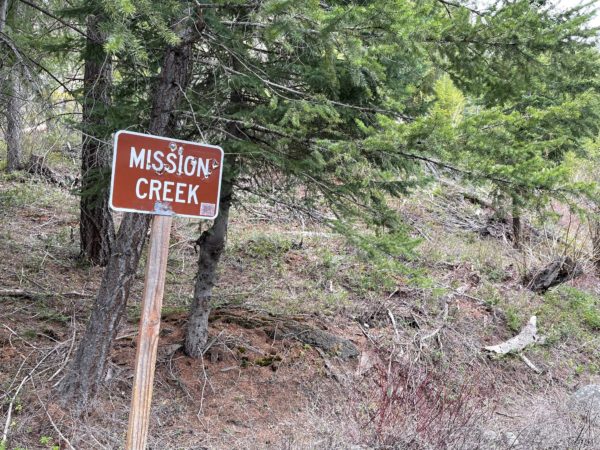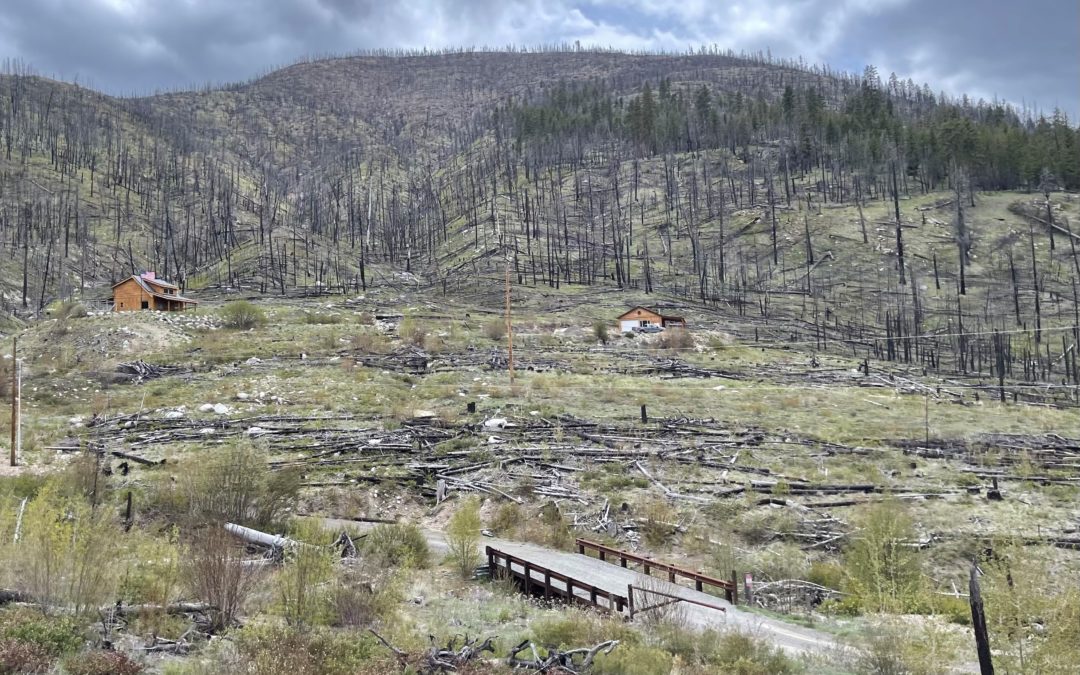There is very little timber being harvested from federal forests in Oregon and Washington these days, despite increasingly severe wildfire seasons and a widely acknowledged need for fuels reduction. What is also true is that what is harvested is hard won progress, the result of years of research, dialogue, debate, collaboration, and sometimes litigation. National Forest Collaboratives—community-driven groups of diverse interests that include environmental organizations, U.S. Forest Service (USFS) staff, local elected officials, community members and forest products industry representatives—study, support, and monitor restoration projects on federal forestland. Those who join collaboratives do so hoping to help the Forest Service move past the gridlock and reduce fuel loads and health and safety risks associated with wildfire, restore complex forest habitat, and provide much needed timber for wood fiber products.
Most National Forests out west have a Collaborative—some have two. Out on the Okanogan-Wenatchee National Forest, I spent a day with someone who has been in the thick of this work; Anjolene Ngari. Having spent eight years working for the Bureau of Land Management (BLM) as a forestry tech and National Environmental Policy Act (NEPA) analysis team lead, Anjolene knows federal processes and environmental laws better than most. She now works for Hampton Lumber. Her mission is to help forest collaboratives understand the needs and realities of the forest products industry and help facilitate more feasible timber sales that will support Hampton’s sawmills and help pay for additional restoration work on these lands.

Anjolene Ngari, Hampton Collaborative Forestry Manager
In early summer I toured the Mission Restoration Project outside of Twisp, Washington with Anjolene. This is a U.S. Forest Service “restoration thinning” project. While a dizzying array of governmental jargon accompany these projects, what they ultimately amount to is active stewardship and restoration of public forestland. Hampton was selected to lead commercial thinning on 1,522 acres of the 50,200 acre restoration project area. Most of the wood harvested here will travel over the pass to Hampton’s sawmill in Darrington, Washington. As we walked through densely packed forestland in the Eastern Washington dry forest landscape, Anjolene pointed out unhealthy trees and important habitat. Being a native of Oregon’s “wetside” forests myself and unfamiliar with these dryer climates, Anjolene prodded me to lean in and really smell a large ponderosa pine along the roadside. She grinned widely as I press my face against the dense bark.
“Smell that?” she asks. “Sugar cookies!”
The distinctive vanilla aroma that emanates from ponderosas reminds her of her youth growing up in North Central Washington. That night we have dinner at Three Fingered Jack’s Saloon in Winthrop, Washington, one of her childhood haunts. She loves this land and the people who work it. It shows in everything she does.
Restoration projects are important for a variety of reasons, the most pressing of which is preventing catastrophic wildfire. Residents near this project area are threatened by frequent and increasingly severe wildfire events and drought. Choking wildfire smoke blankets the area through much of the summer. On densely packed federal forestlands, there is also need to maintain and improve critical wildlife habitat, restore hydrologic function and soil productivity, and maintain access roads needed for not only recreation but wildfire suppression and evacuation. The timber thinning activities associated with this project, which take place on just four percent of the total project area, funds all this non-harvest related work.
We spend years debating and trying to ensure each and every aspect of a forest restoration project is perfect on paper. It’s just not always realistic and it compromises our ability to do good and meaningful work in a timely manner.
– Anjolene Ngari
Anjolene knows the Mission Restoration Project well. The North Central Washington Forest Health Collaborative she serves on has been advocating for its implementation for years. She is knowledgeable, she is passionate, and she is frustrated by the slow pace of restoration project planning. While reaching the implementation phase of this project is a relief, it is also overdue. It has been nearly a decade since the forest service first suggested this treatment was necessary. It took four years to plan the project, then it languished for years in the courts. In late 2020, a federal judge ruled that the USFS had indeed done due diligence and could proceed with the project.
We walk among trees marked for preservation with spray paint years ago by the Forest Service. Wildfire mitigation protocols for this project recommend leaving one tree every 45 feet. The spray paint tells a different story—one of excessive caution from an agency being torn in a multitude of directions and paralyzed by conflict. Hampton Forester, Kris McCall was also visiting the forest that day to walk through the treatment area with our logging contractor, Janecki Logging & Construction, which like Hampton, is a fourth-generation family-owned business. Unfortunately, few trees have been marked for removal in this project area and many of those are unsuitable for lumber processing.

Hampton Forester, Kris McCall reviews treatment plans with Mission Project contractors.
“It’s hard to see how this is mitigating wildfire risk,” says McCall. “And we might end up working this harvest at a loss,” he adds. “We need the wood and we want to be supportive of what the Forest Service and the community are trying to do here but these sales wouldn’t be considered viable under any other land ownership.”
The frustration extends to the logging crews who decide to work on these projects only to find the harvest plans result in little economic value. Too many trees left behind also creates tight and dangerous operating conditions for their crews.
Poorly designed harvest treatments that leave too much wood behind can lead to significant delays. Like other public landowners, the Forest Service puts up timber sales and solicits bids for the work. Unfortunately, these requests too often go unanswered as contractors are reluctant to take on the economic burden. The Forest Service then has to go back to the drawing board to try to fix the sale to make it economically feasible. It can take another 2-3 years before a sale is reoffered, putting project areas at risk of complete loss from fire before a sale ever gets underway.
The question that lingers unanswered in the air that day; how many times can timber purchasers be expected to take a loss to get these fuels out of the forest? If forest sector businesses can’t afford to participate, how will this work get done? This is an ongoing concern for Anjolene. She spends weeks on the road, travelling to meet with collaboratives, tour forestland, and advocate for sensible and cost-effective timber thinning treatments. The pace is slow and the need is great.

Why do projects take so long to complete and too often fall short economically? “The perfect is often the enemy of the good and necessary,” says Anjolene. “It’s analysis paralysis. We spend years debating and trying to ensure each and every aspect of a forest restoration project is perfect on paper. It’s just not always realistic and it compromises our ability to do good and meaningful work in a timely manner.”
What keeps Anjolene up at night? That all this work won’t happen in time to prevent a catastrophic wildfire event. Frequent low severity wildfire is natural in this area but it’s increasingly severe and destructive for the forest and nearby communities. The Forest Service, which manages 145.2 million acres of forestland in the U.S., recognizes the risk. In January 2022, the agency released a strategy for confronting the wildfire crisis. 63 million acres of Forest Service is at high risk of catastrophic wildfire, a third of which the agency hopes to treat by 2032. At the current pace of treatment, it will take many decades to achieve the fuels reduction the region needs today. “I don’t think we have the luxury of such a timeline,” says Anjolene. 4.1 million acres of Forest Service land burned in 2021 alone.
Anjolene is undeterred, however. In fact, the urgency seems to propel her forward. She cares for the people she serves with on the collaboratives, many of whom have different ideas of how to best manage forestlands. She meets them out for a beer. She’s invited over for pie. They talk, and more importantly, they listen. Collaboration is not about putting aside differences –it’s about understanding and working through them. Given the significant need for additional treatments on National Forests in the coming years, collaboratives and the dialogue and trust they enable, seem more important than ever.
Now that winter is upon us, wildfire risk can slip from the minds of many in the Pacific Northwest. Within collaboratives, however, the conversations will continue. Only time will tell whether or not this landscape restoration work can reach the pace and scale needed to address the mounting challenges. One thing is certain for Anjolene; public support is critical.
“If people truly understood the scale of the problem and the benefits of restoration and how committed we all are to improving the landscape, I think we could find the space and resources needed to really move the needle on these forests.”
You can follow Anjolene and her work on Instagram @Hampton_Collaborative_Forestry
Kristin Rasmussen
Hampton Lumber



Anjolene does a great job on the collaborative and I am a member as well. Kudos to Hampton for allowing the collaborative members to visit the Mission project while operations were occurring to help educate them about harvesting.
We are all frustrated by how long it takes to get projects planned and implemented and then we hope it’s economical. I feel we are making a difference. Two of the big Projects we have been reviewing are finally going to yield timber sales. Those are Twisp and Upper Wenatchee Pilot. On the South end of the Forest the other collaborative (Little Naches Working Group) has cleared the way for two more sales this year.
We have to try to build the FS program because the DNR program in Washington is declining. There are going to be collaboratives and if industry doesn’t participate we will never improve on Projects like Mission to try to make them better and more economical for Kris and his contractors.
So Anjolene and the rest of the industry people who spend countless hours on collaboratives, all I can say is keep showing up, because I think you are making a difference!
I am a member of the Darrington Collaborative. Where Anjolene is also a representative for Hampton Lumber. The Forest Service has internal and external factors that impact timelines. After all the public and Forest Service review of a project, National Marine Fisheries Service has the last word. They are the arbitrators of how endangered species will be impacted by the project. Experience and knowledge of an area counts for less than what the Forest Service manual says or what people think will be approved by NMFS or the R6 staff. Field trips and on the ground explanations are critical to positive change.
When there’s been a forest fire, they need to allow them to go in and clear cut that timber out of there while it is still usable. It does nobody good standing there and rotting and making widowmakers. Then the land can be replanted for future timber.
It might mean the logging industry will have to deal with less primo trees. Any gardener will cull the weak and deformed ones first.
On forest lands around me there is so much waste that it would have been better to leave them standing. But that’s on private land and they do what they want. I’m glad the forest service is taking a conservative approach.